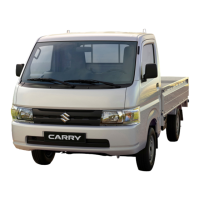3-8
OPERATING YOUR VEHICLE
52SS0-01E
Downshifting maximum allowable speeds
*NOTE:
You may not accelerate to the maximum
allowable speed because of the driving sit-
uation and/or the vehicle condition.
Braking
60G165S
The distance needed to bring any vehicle
to a halt increases with the speed of the
vehicle. The braking distance needed, for
example, at 60 km/h (37 mph) will be
approximately 4 times greater than the
braking distance needed at 30 km/h (19
mph). Start to depress the brake pedal
when there is plenty of distance between
your vehicle and the stopping point, and
slow down gradually.
Downshifting km/h (mph)
2nd to 1st 15 (10)
3rd to 2nd 60 (35)
4th to 3rd 85 (50)
5th to 4th 130 (80)*
WARNING
• Reduce your speed and downshift
to a lower gear before going down
a long or steep hill. A lower gear
will allow the engine to provide
braking. Avoid riding the brakes or
they may overheat, resulting in
brake failure.
• When driving on slippery roads,
slow down before downshifting.
Excessive and/or sudden changes
in engine speed may cause loss of
traction, which could cause you to
lose control.
NOTICE
• Do not downshift to a lower gear at
the speed faster than the maximum
allowable speeds for the next lower
speed, or severe damage to engine
and transmission can result.
• Make sure that the vehicle is com-
pletely stationary before you shift
into “R” (Reverse).
• To help avoid clutch damage, do
not use the clutch pedal as a foot-
rest while driving or use the clutch
to keep the vehicle stationary on a
slope. Depress the clutch fully
when shifting.
• When shifting or starting off, do not
race the engine. Racing the engine
can shorten engine life and cause
negative effect to smooth shifting.

